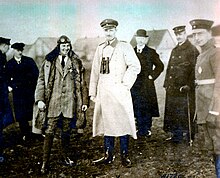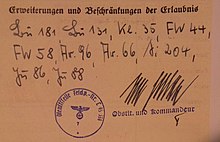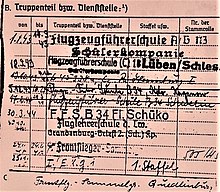Schwerin-Görries Airport
| Schwerin-Görries Airport | |
|---|---|

|
|
| Characteristics | |
| Coordinates | |
| Height above MSL | 46 m (151 ft ) |
| Basic data | |
| opening | 1913 |
| operator | Mecklenburgische Flugplatz-Gesellschaft Görries-Schwerin mbH |
The airport Schwerin-Görries was 1913-1927 country airfield under management of "Mecklenburg airfield Society Görries-Schwerin mbH", from 1932 Airport II order and 1935-1945 one. Airbase of the Air Force of the Armed Forces in Schwerin - Görries .
history

The impetus for the construction of an airfield in Schwerin was given by the German round flight in 1911, during which the royal seat was a stage. In the planning and implementation of the state airfield, city counsel Otto Weltzien and the owner of the piano factory Perzina Daniel Huss stood out in particular. Weltzien convinced the magistrate, citizens' committee, a bank and private individuals to participate financially, Huss got in touch with the director of the Johannisthal airfield . Major a. D. Georg von Tschudi visited the selected tournament field in Görries in the spring of 1912 and found the area to be extremely suitable. In November 1912 the "Mecklenburgische Flugplatz-Gesellschaft Görries-Schwerin mbH" was founded. By Easter 1913, the airfield company had the square leveled and fenced and the Berlin architect Richard Thiede built a grandstand, a restaurant and an aircraft hangar.
In the meantime Daniel Huss negotiated on behalf of the airport company with various aircraft manufacturers about the move to Schwerin. In mid-March 1913 an agreement was reached with Fokker Aeroplanbau GmbH and in May Anthony Fokker opened his flying school in Görries with six Fokker "spiders" . In the 51 months of the First World War , the Schwerin Fokkerwerke produced around 3,400 aircraft and brought out around 110 model aircraft, which were built, tested and approved at the state airfield.
As early as 1915, pilot training was reaching its limits. The flight officers and instructors based in Schwerin tried to set up their own flight station. The deputy general command of the IX. At the beginning of September 1915, the Army Corps ordered the construction of a new pilot station with its own siding. Work south of Rogahner Strasse began immediately. In addition to local construction workers, government master builders Pfeiffer also had Russian and French prisoners of war available. The Fliegerbeobachterschule (FBS) started provisional operations on March 15, 1917.
After the end of the First World War, Fokker moved large parts of his company to the Netherlands. A part of the aircraft hangars of the Fokkerwerke had been demolished on the orders of the Allies, despite being rededicated as an emergency landing site, the area lay fallow for a while. A private aviation company founded in 1925 gave up after a short time, and a flight connection Hamburg –Schwerin– Stettin was discontinued due to high costs. The airfield company disbanded in December 1927, and in the same year the former restaurant was demolished due to its dilapidation.
At the end of the war there were 511 aircraft on the premises of the Fliegerbeobachterschule, 14 of which were operational, the rest had been dismantled and parked. According to the Idflieg plans, 40 officers, 400 soldiers and 200 civilian employees were to remain at the airfield, but the Versailles Treaty completely changed the situation. A police squadron and a motor vehicle department used the technical facilities and accommodations until the spring of 1920, but by February 15, 1921, the airfield had to be cleared of all military units. Part of the hangar on Rogahner Strasse had been demolished on the orders of the Allies. In their place, the city of Schwerin built a home for refugees, the so-called "Oberschlesierheim". In the remaining hangars and the shipyard, pillars had to be drawn in in the middle to prevent further use as an aircraft hangar. The former soldiers' barracks were rented out by an "industrial settlement company" to refugees, homeless people and those returning from war. Industrial settlements initiated by the city ( Kostowerke , Maschinenfabrik Badenia and Benno Schilde AG) failed. In the remaining buildings, the decline continued through vacancy and vandalism.
It was not until 1932 that the German Commercial Aviation School (DVS) was upgraded as a civil airport to wake the former state airfield from its deep slumber. The last public flight event took place on June 23, 1934 at the airfield, when Schwerin was once again a stage in the Germany flight . In September DVS acquired the entire airfield site from the city and began large-scale renovation work. The Rogahner Straße was closed, the buildings of the industrial settlement company, the FBS and the Fokkerwerke partially demolished and a new runway created. At the north-eastern end of the area there were farm buildings, aircraft hangars, crew and officers' quarters, several large shooting ranges for weapons tests, ammunition bunkers, an aircraft yard, a control center with a fire station and an infirmary. With the establishment of the air base command, military flight operations began again in 1935.
Before and during the Second World War , Görries served various training squadrons, hunting and combat squadrons as a stopover. The following table shows a list of selected active air units (excluding school and supplementary units) of the Luftwaffe that were stationed here between 1935 and 1945.
| from | to | unit | equipment |
|---|---|---|---|
| October 1935 | March 1937 | I./StG 162 (I. Group of Sturzkampfgeschwader 162) | Heinkel He 50 , He 51 , Henschel Hs 123 |
| March 1937 | October 1938 | III./KG 152 ( III.Group des Kampfgeschwader 152) | Dornier Thursday 23 |
| November 1938 | August 1939 | II./LG 1 (II. Group of training squadron 1) | Heinkel He 111 |
| September 1939 | October 1939 | II./KG 26 | |
| December 1939 | February 1940 | I./KG 28 | |
| August 1943 | December 1943 | III./JG 54 ( III.Group of Jagdgeschwader 54) | Messerschmitt Bf 109 G |
| October 1944 | October 1944 | I./JG 5 | |
| October 1944 | December 1944 | III./JG 6 | |
| April 1945 | April 1945 | II./JG 27 |
In the spring of 1940 a group of bombers was stationed on the airfield for operations against Great Britain . Since then, various bomber units and transport groups have come to the air base to refresh and upgrade. The North German Dornier works Wismar laid in the spring of 1944 the construction of license aircraft at various locations. Fw 190 and Fw 200 were assembled in Görries Focke-Wulf under the code name “Vosswerk” . For example, group IV of KG 40 carried out test and training flights with Focke-Wulf Fw 200 on site.
American and British bombs fell on Görries Airfield in August 1944 and April 1945, destroying most of the buildings. After the air raids, the NDW moved the construction and test flights to Lübeck-Blankensee , Neustadt-Glewe and Perleberg . Today only the almost dilapidated control center, two hangars and a building of the Aircraft Office testify to the former use. The northeastern part of the airfield area on the Hollenbäk was a property of the group of the Soviet armed forces in Germany after the Second World War until 1993 . An industrial area for wholesalers and warehouses as well as the construction and building materials industry was created south of Rogahner Straße in 1954. This includes the supply office for pharmacy and medical technology in Baustraße 3, built in 1957. In 1958, the merger of several small saddler, shoemaker, interior decorator, upholsterer and leather processing companies resulted in the Leather Goods Production Cooperative (PGH), for which several buildings were built originated in Görries. In 1959/60 the multi-purpose cold store was built in Handelsstraße and from 1964 the high-rise and warehouse of GHG household goods was built in Rogahner Straße.
In order to preserve the evidence of Schwerin's aviation history, the state capital has placed the former airfield buildings in the Görries industrial park under a preservation order.
Aviation training schools in Schwerin-Görries
| school | from ... to | Airplane type | comment |
|---|---|---|---|
| Fokker flight school | May 1913 | Fokker M.1 spider | |
| Airborne Observation School, FSB | March 1917 February 1921 | ||
| German commercial aviation school | 1932 | Civil flight school, commencement of military flight operations from 1935 | |
| Blind flight school 4, BFS 4 | Nov. 1939 April 1941 | Bü 181 , Bü 131 , Kl 35 , Si 204 , Ar 66 , Ar 96 , Fw 44 , Fw 58 , Ju 86 , Ju 88 | Blind flight space satellite Schwerin Görries |
| Aviation pilot school B34, FFS B34 | April 1941 October 1944 | Blindflugschule 4 (BFS 4) Vienna-Aspern was dissolved on April 4, 1941, BFS 34 Copenhagen-Kastrup with the satellite airports Schwerin-Görries , (Kdo. Hagenow ), Neumünster , Kolberg , Pütnitz , Vaerlose , on February 4, 1945 | |
| Aircraft piloting school A72 | May 1944 April 1945 | Satellite airfields Neustadt-Gleve , Güstrow , Sülte , flight operations ceased on April 30, 1945, relocation to Leck , May 1, 1945 American forces occupy the airfield |
Well-known trainers and trained
- Anton Herman Gerard Fokker - aviator and instructor in his in-house flight school
- Walther Bruns - 1913 student pilot at the Fokker flight school
- Paul Graetz - 1914/15 command leader of the Görries military aviation school
- Kurt Wintgens - 1915 training as an aviator at the Görries Military Aviation School
- Ernst Eberstein - 1917 commander and instructor of the FBS Schwerin-Görries aerial observer
- Hanns-Gerd Rabe - 1918 training as an air observer at the FBS Schwerin-Görries
- Werner Mölders - 1935 instructor in the Sturzkampfgeschwader (StG) 162 "Max Immelmann"
literature
- Volker Koos: The Fokker aircraft works in Schwerin: history - production - types . Reinhard Thon, Schwerin 1993, ISBN 3-928820-21-4 .
- Peter M. Grosz, Volker Koos: The Fokker aircraft factories in Germany 1912–1921 . Heel, Königswinter 2004, ISBN 3-89880-355-4 .
- Michael Schmidt: Aircraft construction in Schwerin 1913–1926 . Mecklenburg and the First World War. Thomas-Helms-Verlag, Schwerin 2010, ISBN 978-3-940207-19-7 .
- Jürgen Zapf: Airfields of the Air Force 1934–1945 . tape 5 Mecklenburg-Western Pomerania. VDM Heinz Nickel , Zweibrücken 2006, ISBN 978-3-86619-011-5 .
- Bernd Kasten and Jens-Uwe Rost: Schwerin. History of the city. Thomas Helms Verlag, Schwerin 2005, ISBN 3-935749-38-4 .
- Reinhard Parchmann: Military buildings in Mecklenburg 1800–1918. Series of publications by the studio for history and portrait painting, Volume 9, Schwerin 2001, ISBN 3-00-008019-8 .
Web links
Individual evidence
- ↑ Michael Schmidt: The Schwerin-Görries airfield was opened 100 years ago . In: Klassiker-der-luftfahrt.de . Retrieved on February 22, 2016. ( Page no longer available , search in web archives ) Info: The link was automatically marked as defective. Please check the link according to the instructions and then remove this notice.
- ^ Reinhard Parchmann: Military buildings in Mecklenburg 1800-1918. , Series of publications by the studio for history and portrait painting, Volume 9, Schwerin 2001, p. 91 ff.
- ↑ Bernd Kasten and Jens-Uwe Rost: Schwerin. History of the city. Thomas Helms Verlag, Schwerin 2005, page 127 ff.
- ↑ Henry L. deZeng IV: Air Force Airfields 1935-1945 Germany (1937 Borders). (PDF; 3.3 MB) June 2014, p. 608f. , accessed on February 6, 2019 .
- ↑ Jürgen Zapf: Airfields of the Air Force 1934-1945 , Volume 5 Mecklenburg-Western Pomerania, Zweibrücken 2006, page 375 ff.
- ↑ Alexander Steenbeck: The Dark Years: The Lübeck-Blankensee Airport in the 1930s and 40s , Lübeck 2009, page 147 ff.
- ↑ Bernd Kasten: On the history of the Schwerin-Görries airfield 1912–1945 , in: Weg über Bundesland , Möller / Karge, Schwerin 2002, page 129 ff.
- ↑ Route of Industrial Culture Schwerin: 20 stations in industrial history. .
- ^ Gert Steinhagen: Old Schwerin airfield: Mysterious work in Görries . In: svz.de . April 1, 2015. Accessed February 22, 2016.
- ↑ List of monuments in the state capital of Schwerin . Retrieved March 17, 2019.
- ↑ Kurt Braatz: Werner Mölders. The biography. Twenty-nine six publishing house, Moosburg 2008, p. 104 ff.






